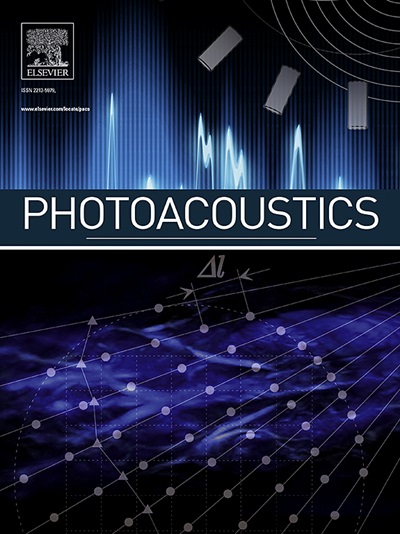提高实时led光声成像的信噪比:基于cnn的深度学习架构的比较研究。
IF 7.1
1区 医学
Q1 ENGINEERING, BIOMEDICAL
引用次数: 0
摘要
发光二极管(LED)技术的最新进展使更经济实惠的高帧率光声成像(PA)取代了传统的基于激光的PA系统,后者昂贵且脉冲重复率低。然而,led的一个主要缺点是低能量输出,不能产生高信噪比(SNR) PA图像。最近在集成深度学习方法方面取得了一些进展,旨在解决提高LED-PA图像信噪比的挑战,但缺乏对不同数据集和架构的全面评估。在本研究中,我们系统地评估了各种基于编码器-解码器的CNN架构在基于led的实时PA成像中提高信噪比的有效性。通过体外模型、离体小鼠器官和体内肿瘤的实验,我们比较了基本的卷积自编码器和U-Net架构,探索了U-Net内部的层次深度变化,并评估了U-Net的高级变体。我们的研究结果表明,虽然U-Net架构通常表现出相当的性能,但Dense U-Net模型在去噪PA图像中的不同噪声分布方面显示出前景。值得注意的是,层次深度变化并没有显著影响性能,这强调了标准U-Net架构在实际应用中的有效性。此外,该研究强调了评估对不同噪声分布的鲁棒性的重要性,密集U-Net和R2 U-Net显示了对高斯、盐和胡椒、泊松和斑点噪声类型的弹性。这些见解为基于应用需求和资源限制选择适当的深度学习架构提供了信息,有助于PA成像技术的进步。本文章由计算机程序翻译,如有差异,请以英文原文为准。
Enhancing signal-to-noise ratio in real-time LED-based photoacoustic imaging: A comparative study of CNN-based deep learning architectures
Recent advances in Light Emitting Diode (LED) technology have enabled a more affordable high frame rate photoacoustic imaging (PA) alternative to traditional laser-based PA systems that are costly and have slow pulse repetition rate. However, a major disadvantage with LEDs is the low energy outputs that do not produce high signal-to-noise ratio (SNR) PA images. There have been recent advancements in integrating deep learning methodologies aimed to address the challenge of improving SNR in LED-PA images, yet comprehensive evaluations across varied datasets and architectures are lacking. In this study, we systematically assess the efficacy of various Encoder-Decoder-based CNN architectures for enhancing SNR in real-time LED-based PA imaging. Through experimentation with in vitro phantoms, ex vivo mouse organs, and in vivo tumors, we compare basic convolutional autoencoder and U-Net architectures, explore hierarchical depth variations within U-Net, and evaluate advanced variants of U-Net. Our findings reveal that while U-Net architectures generally exhibit comparable performance, the Dense U-Net model shows promise in denoising different noise distributions in the PA image. Notably, hierarchical depth variations did not significantly impact performance, emphasizing the efficacy of the standard U-Net architecture for practical applications. Moreover, the study underscores the importance of evaluating robustness to diverse noise distributions, with Dense U-Net and R2 U-Net demonstrating resilience to Gaussian, salt and pepper, Poisson, and Speckle noise types. These insights inform the selection of appropriate deep learning architectures based on application requirements and resource constraints, contributing to advancements in PA imaging technology.
求助全文
通过发布文献求助,成功后即可免费获取论文全文。
去求助
来源期刊

Photoacoustics
Physics and Astronomy-Atomic and Molecular Physics, and Optics
CiteScore
11.40
自引率
16.50%
发文量
96
审稿时长
53 days
期刊介绍:
The open access Photoacoustics journal (PACS) aims to publish original research and review contributions in the field of photoacoustics-optoacoustics-thermoacoustics. This field utilizes acoustical and ultrasonic phenomena excited by electromagnetic radiation for the detection, visualization, and characterization of various materials and biological tissues, including living organisms.
Recent advancements in laser technologies, ultrasound detection approaches, inverse theory, and fast reconstruction algorithms have greatly supported the rapid progress in this field. The unique contrast provided by molecular absorption in photoacoustic-optoacoustic-thermoacoustic methods has allowed for addressing unmet biological and medical needs such as pre-clinical research, clinical imaging of vasculature, tissue and disease physiology, drug efficacy, surgery guidance, and therapy monitoring.
Applications of this field encompass a wide range of medical imaging and sensing applications, including cancer, vascular diseases, brain neurophysiology, ophthalmology, and diabetes. Moreover, photoacoustics-optoacoustics-thermoacoustics is a multidisciplinary field, with contributions from chemistry and nanotechnology, where novel materials such as biodegradable nanoparticles, organic dyes, targeted agents, theranostic probes, and genetically expressed markers are being actively developed.
These advanced materials have significantly improved the signal-to-noise ratio and tissue contrast in photoacoustic methods.
 求助内容:
求助内容: 应助结果提醒方式:
应助结果提醒方式:


